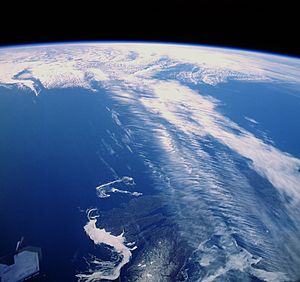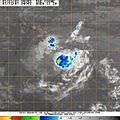Jet stream facts for kids
Jet streams are like super-fast rivers of wind high up in Earth's atmosphere. They are found about 12 kilometers (7.5 miles) above the ground. This is just below the tropopause, which is the boundary between two layers of the atmosphere.
These powerful air currents form where very different air masses meet. For example, they form where cold air from the polar regions meets warmer air from closer to the equator. Because our Earth spins, these wind currents mostly flow from west to east. This happens in both the Northern and Southern Hemispheres due to something called the Coriolis effect. The paths of these wind rivers often look wavy, like a snake. These wavy patterns also move eastward, but slower than the wind itself.
Contents
What Are Jet Streams?
There are two main types of jet streams. The strongest ones are found near the North and South Poles. These are called polar jet streams. There are also two weaker ones closer to the equator, known as subtropical jet streams.
The speed of the wind in a jet stream changes with the temperature. In summer, they average about 55 kilometers per hour (35 mph). In winter, they speed up to about 120 kilometers per hour (75 mph). Sometimes, they can even reach over 400 kilometers per hour (250 mph)! To be officially called a jet stream, the wind speed must be higher than 90 kilometers per hour (55 mph).
Why Do Jet Streams Form?
Jet streams form because of differences in air temperature and Earth's rotation. Winds are usually strongest high up in the atmosphere, just below the tropopause. This is true except during extreme weather like tornadoes or hurricanes.
When two air masses with different temperatures meet, they create a difference in air pressure. This pressure difference is strongest at high altitudes. If one air mass is north of the other, the wind doesn't just flow directly from the warm area to the cold area. Instead, the Coriolis effect pushes the wind sideways. This makes the wind flow along the border between the two air masses, creating the fast-moving jet stream.
Discovery of Jet Streams
The first person to discover jet streams was a Japanese meteorologist named Wasaburo Ooishi. He found them in the 1920s by tracking weather balloons.
During World War II, American pilots flying high-altitude B-29 bomber planes noticed these strong winds. They found it was very hard to bomb targets accurately because of the powerful winds. Later, a meteorologist named Erik Palmén and others helped explain the theory behind jet streams. The Japanese military actually used jet streams during World War II. They launched fire balloons that floated across the Pacific Ocean to the American mainland using these winds.
How Jet Streams Are Used
Knowing where the jet stream is located is very important for airlines. For example, a flight going east across the United States or Canada can be about 30 minutes faster if the airplane flies with the jet stream. If the plane has to fly west against it, the flight can take about 30 minutes longer.
For international flights, the difference can be even bigger. It's often faster and cheaper to fly along the jet stream, even if it means taking a slightly longer route.
Weather experts, called meteorologists, also use jet streams. They know that the path of the jet stream guides big storm systems, like cyclones, that are closer to the ground. So, understanding where the jet stream is helps them predict the weather more accurately. Jet streams also play a role in creating powerful storms called supercells, which can lead to tornadoes.
Images for kids
-
Hurricane Flossie over Hawaii in 2007. Notice the large band of moisture that developed east of Hawaii Island that came from the hurricane.
See also
 In Spanish: Corriente en chorro para niños
In Spanish: Corriente en chorro para niños





